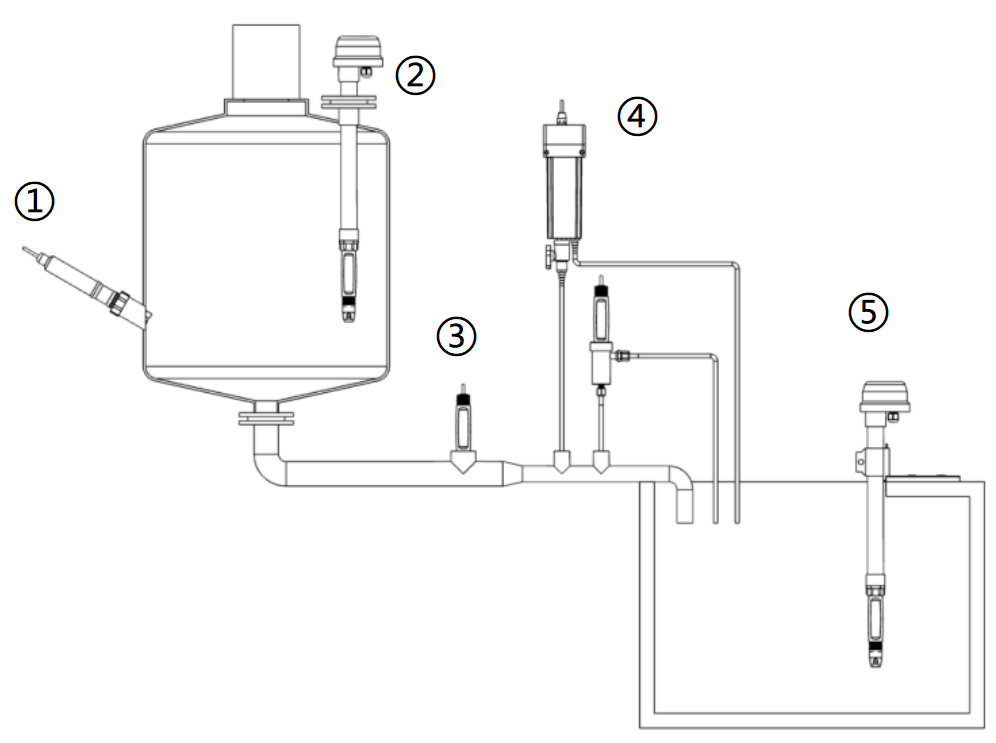Sodium Hypochlorite Solution Analog ORP Electrode ORP Sensor
>>Technical Parameter
ORP Range: ±1000mV
Temperature Range: 0-80℃
Pressure Resistance: 0-0.6MPa
Temperature Sensor: OEM
Housing Material: Glass
Sensitive Membrane: Platinum (Pt)
Connection Thread: PG13.5
Cable Length: 5m or as agreed
Cable Connector: Pin, BNC, or as agreed
>>Overview
The core theory of pH electrode measurement is the Nernst equation.
The sensor used in potentiometric analysis is called a galvanic
cell. A galvanic cell is a system that converts chemical reaction
energy into electrical energy. The voltage of this cell is referred
to as the electromotive force (EMF). This EMF consists of two
half-cells. One half-cell is the measuring sensor, whose potential
is related to the activity of specific ions; the other is the
reference half-cell, often called the reference sensor, which is
typically connected to the measurement solution and the instrument.
ORP (Oxidation-Reduction Potential) is a critical indicator of
water quality. While it cannot independently determine water
quality, it reflects the ecological environment of aquatic systems
by integrating other water quality parameters.
In water, each substance has its unique redox properties.
Simplistically, this can be understood as: at a microscopic level,
different substances possess varying oxidation-reduction
capacities. These substances interact to form an overall
macroscopic redox characteristic. ORP reflects the collective redox
behavior of all substances in the solution. A higher ORP indicates
stronger oxidizing capacity, while a lower ORP suggests weaker
oxidizing capacity. A positive potential signifies oxidizing
properties, whereas a negative potential indicates reducing
properties.
>>Installation Diagram
Before use, unscrew the electrode protective cap and install it
with the appropriate mounting bracket or accessories.

1. Sidewall Installation: Ensure the interface tilt angle exceeds 15 degrees.
2. Top Flange Installation: Note flange dimensions and electrode insertion depth.
3. Pipe Installation: Consider pipe diameter, flow velocity, and pressure.
4. Flow-Through Installation: Monitor flow velocity and pressure.
5. Submersion Installation: Adjust bracket length as needed.
>>Electrode Maintenance and Care
○ Before use, unscrew the protective cap and immerse the electrode
bulb and liquid junction in the sample.
○ If salt crystals form near the electrode tip or inside the cap
due to electrolyte evaporation, rinse with water. This indicates
normal dialysis membrane function.
○ Check for air bubbles in the glass bulb by shaking the electrode
vertically.
○ Keep the glass membrane hydrated for fast response. After
measurement or calibration: Rinse the electrode thoroughly. Add
storage solution (3 mol/L KCl) to the protective cap.
○ Ensure terminal connections remain dry. Clean with anhydrous
alcohol if contaminated.
○ Avoid prolonged immersion in distilled water, protein solutions,
or contact with silicone grease.
○ For aged electrodes with cloudy membranes or deposits, soak in
10% HCl, then rinse.
○ Regularly clean and calibrate the electrode. If calibration fails
after maintenance, replace the electrode.
>>Lifespan
Under normal conditions with proper maintenance, electrodes last
over 12 months. Even unused electrodes have a shelf life of 12–24
months (if stored correctly). Exposure to strong acids, bases, high
temperatures, or corrosive liquids shortens lifespan. Electrodes
are consumables and generally not covered by warranty.
>>Electrode Calibration
○ Use fresh pH/ORP standard buffer solutions of appropriate
concentrations.
○ Remove the protective cap and rinse the electrode with distilled
water.
○ Set the instrument to calibration mode (refer to the instrument
manual for details).
○ After calibration, measure actual samples.













